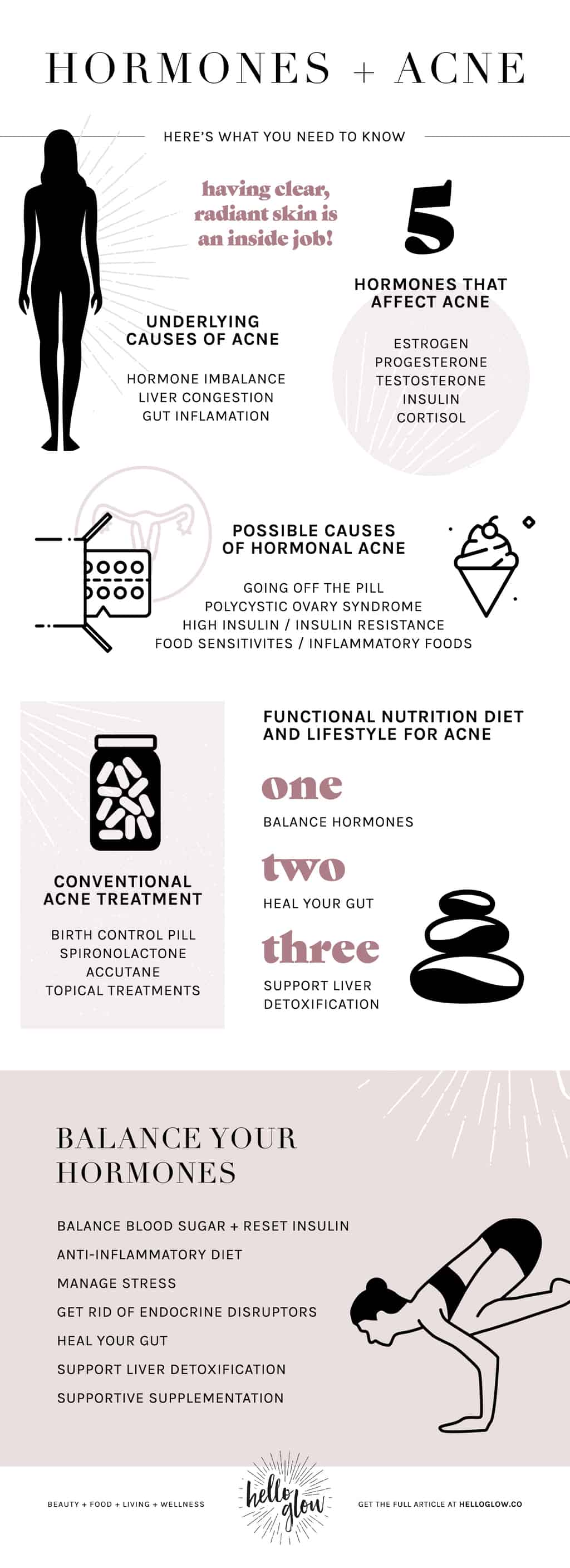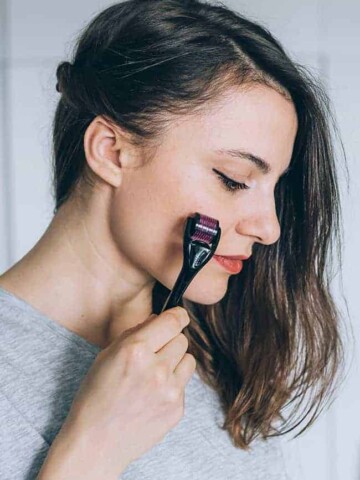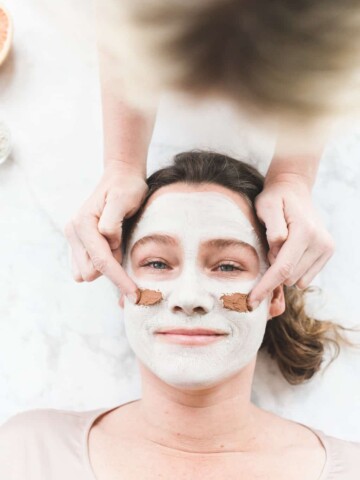If you struggle with adult acne, you are not alone! According to the American Academy of Dermatology, research has shown that up to 50 million people in the US are affected by acne each year. It typically starts in the teenage years but can continue in some people to their 40s [source]. But even if you never experienced breakouts as a teenager, you can be plagued by acne as an adult.
What is hormonal acne?
Hormone imbalances can often cause or contribute to adult acne. As we age, skin renewal slows, and it becomes more difficult to shed dead skin cells. If our hormones are out of balance, those dead skin cells will become sticky. This leads to dry, dull skin, clogged pores, and breakouts. Menstrual cycles and menopause often exacerbate hormonal acne as well.
From a holistic perspective, all of our body systems are interconnected, so if one system is out of whack, it influences the others. The underlying cause of acne is related to many factors, including any of the following: hormonal imbalance affecting the follicles and sebum production, inflammatory mediators, and bacterial imbalances [source].
We are going to focus on women’s hormonal imbalance here, but we can’t talk about hormones without also addressing the liver and gut!
Acne’s Underlying Causes
1. Hormonal imbalance
If your period is all over the place, it’s a sign that something is off with your hormones, and your skin may be suffering as a result. If you don’t have regular cycles or your cycles are very symptomatic (e.g., headaches, bloating, cramps, intense cravings, etc.), particularly during the premenstrual phase, then working to balance your hormones becomes key.
2. Liver congestion
Our skin is our biggest organ of elimination. It works within a system that includes the liver, kidneys, lymphatic system, and large intestine. Everything that goes into your body (food, water, air, skin products, household cleaners, etc.) must be filtered by the liver and eliminated properly.
If the elimination organs aren’t working optimally, toxins will build up. They have to come out somewhere, and unfortunately, they can show up on your face as acne.
3. Gut inflammation
Even if you don’t have overt gut issues (like frequent diarrhea, gas, and bloating), you can still have underlying inflammation in the digestive tract. Leaky gut, dysbiosis, and inadequate production of stomach acid and pancreatic enzymes can all lead to increased intestinal inflammation, a major root cause in acne.
The Hormones Involved in Hormonal Imbalance and Acne
The five hormones discussed below are big players when it comes to acne.
1. Estrogen
High estrogen in relation to progesterone (estrogen dominance) is a root cause in many hormonal imbalance conditions, such as PMS, polycystic ovary syndrome (PCOS), and endometriosis. Estrogen dominance can be caused by exposure to xenoestrogens (toxic compounds that mimic estrogen and wreak havoc on your endocrine system) and inadequate estrogen clearance due to sluggish liver function.
If your liver is overworked dealing with other toxins, estrogen does not get properly metabolized and may then be recirculated back into your system. The resulting high estrogen levels can cause skin inflammation and acne.
2. Progesterone/testosterone
Too much testosterone increases the skins’ production of sebum [source], which clogs pores and causes acne. At the skin level, testosterone gets converted into DHT, a more aggressive form of testosterone that causes an overdrive of oil production, leading to more acne [source].
Adequate amounts of progesterone are key because progesterone prevents the conversion of testosterone into DHT. However, many women (such as those with estrogen-dominance conditions) have low progesterone. So, high estrogen, high testosterone, and low progesterone create a perfect storm for acne, which is why acne is so common in women with PCOS [source].
3. Insulin
Insulin is the hormone that gets secreted by the pancreas to shuttle glucose into our cells so it can be used as fuel. A diet full of sugar and simple starches leads to high insulin levels, which catalyze acne in a variety of ways.
High insulin makes testosterone more active and increases IGF-1 (just as dairy does, as you’ll see in a bit), which is a growth hormone that leads to more oil production and thus more breakouts [source].
4. Cortisol
We know cortisol as our stress hormone. One of the mechanisms of cortisol is that it tells the body to release more sugar into the bloodstream, causing high blood sugar and high insulin levels.
That could be a positive thing if you were being chased by a wild animal, but not really helpful in dealing with many of the stresses of today. The chemical changes that result from excess cortisol lead to increased inflammation, and the vicious cycle continues!
Possible Causes of Hormonal Acne
Now that you’ve got the low-down on the major hormonal players, let’s dig into the possible causes of hormonal acne.
Going off the hormones
Certain types of hormonal birth control suppress acne/sebum production by altering the level of free testosterone in the circulation [source]. Many women are put on hormonal birth control to help their acne.
Estrogen stimulates the production of sex hormone-binding globulin that binds to free testosterone, preventing its action on the sebaceous unit (the oil-producing gland in your pores where acne originates).
Unfortunately, it is not uncommon for women’s acne to come back with a vengeance after going off hormones. Post-birth control pill acne is the result of 1) rebound sebum production due to an increase in free testosterone, and 2) rebound androgen (male hormones like testosterone) production from your ovaries.
This rebound effect can last a few months while your hormones work to regulate themselves. The worst time for acne is typically about 3 months after stopping the hormones. As long as your period returns and your body starts making its own natural estrogen and progesterone again, acne should subside.
Polycystic ovary syndrome (PCOS)
Many women with PCOS have high insulin, estrogen dominance, and elevated testosterone, which increases sebum, skin inflammation, and acne [source].
High insulin/insulin resistance
Insulin activates insulin growth factor (IGF-1), which increases sebum, keratin, and inflammation [source], the three enemies of clear skin!
Food sensitivities/inflammatory foods
Acne, at its root, is an inflammatory condition, so it’s made worse by consuming inflammatory foods such as gluten, dairy, and sugar. While those foods are typically known as “the big three,” there are a handful of other common inflammatory trigger foods, such as highly processed food, saturated fats [source], high fructose corn syrup [source], red meat and processed meats [source], eggs [source], and alcohol [source].
Beyond these major inflammatory food categories, identifying your personal food sensitivities is important for balancing your hormones and reducing inflammation.
Conventional Hormonal Acne Treatment
The problem with standard hormonal acne treatments is that they do nothing to target the root cause. Instead, they are masking the symptoms and, in some cases, causing more harm than good.
Oral contraceptive pill
More often than not, women suffering from acne in their reproductive years are prescribed oral contraceptive pills [source]. For most women, taking hormones helps reduce breakouts by providing a big dose of synthetic estrogen and progestin and ramping up sex hormone-binding globulin, which binds to testosterone and lowers its activity [source].
Because the overall production of hormones is lower due to the effect of external hormones on ovulation, the result is improved skin. But there are risks and side effects related to the use of hormones, and not everyone is a good candidate for this therapy [source].
Spironolactone
This medication is the same drug that is used in the birth control pill, Yasmin. It suppresses androgens and inhibits sebaceous gland activity, which reduces acne formation. This is a great treatment for those tender, long-lasting, deep pimples around the jaw and chin.
My issue with spironolactone is that, similar to the birth control pill, it disrupts ovulation, estrogen metabolism, and adrenal function. And it is associated with some adverse side effects such as inflammatory bowel disease (IBD), menstrual irregularities, loss of libido, and depression [source].
Retinoids
Retinoids are derived from vitamin A and help rapidly exfoliate the skin--this accelerated cell turnover helps clear clogged pores and remove the discolored cells left behind when acne resolves. You can find both over-the-counter and prescription-strength retinoids.
Functional Nutrition Diet and Lifestyle for Acne
I work with a holistic and natural approach to treating acne. Whenever a client wants to clear her skin, I use a three-pronged approach:
1. Balance the hormones - sex hormones (estrogen, progesterone, testosterone), insulin, and cortisol
2. Heal the gut
3. Support liver detoxification
Before we get into these three in more detail... just a quick note to women who are on birth control pills and worried about getting off and getting your acne back. First of all, if you are on hormones for contraception, do not stop until you are placed on another form of contraception.
I recommend starting the treatment below a couple of months before stopping the oral contraceptives. That way, your skin will be less reactive and better equipped to withdraw from synthetic hormones.
Step 1: How to Balance Your Hormones
1. Balance Blood Sugar and Reset Insulin
As mentioned above, balanced blood sugar is the first critical step in balancing hormones. You can do this with your diet by eating protein, fat, and especially fiber at every meal.
Choose unprocessed carbs with more fiber, such as vegetables and low-sugar fruits, instead of processed grains and starches. Read my top 10 tips for balancing blood sugar here.
2. Anti-Inflammatory Diet
I recommend avoiding inflammatory triggers found in the typical Western diet [source], such as sugar, gluten, dairy, all processed foods and snacks, high-fructose corn syrup, fried foods, saturated animal fats [source], omega-6 fatty acids in the form of processed vegetable oils (canola, sunflower, grapeseed, etc.), red and processed meats, and alcohol. Whew!
Getting all of those unhealthy things out of your diet allows you to focus on maximizing your intake of plants, fiber, and omega-3 fatty acids [source] for at least 3–4 weeks as you begin your skin-healing journey (and you can certainly continue to do this going forward for optimum health).
Removing dairy, in particular, can be a game-changer [source]. Dairy causes acne because it contains highly saturated animal fat, and it spikes both insulin and IGF-1 [source]. It is also one of the top inflammatory foods due to a protein called A1 casein, which stimulates the immune system to produce inflammatory factors called cytokines [source].
Sugar (and everything like it) is another significant food category to limit as much as possible because it increases insulin levels, and like dairy, it spikes IGF-1. Studies have shown an improvement in acne when subjects were given a low glycemic load diet [source].
The foods that reduce inflammation and help to clear your skin are mostly plants [source], typified in the Mediterranean diet [source] as well as vegetarian (without dairy) and vegan diets.
These diets basically maximize your intake of whole plant foods that are naturally packed with fiber, such as vegetables and fruits, whole grains, and legumes, and healthy fats (avocados, nuts, seeds, etc.). Incorporate these 10 inflammation-fighting foods as much as possible.
3. Manage Stress
Managing stress levels is critically important for reducing chronically elevated cortisol, which spikes blood sugar and insulin. Remember what happens when insulin is high? Acne. Find any activity that flushes cortisol and makes you feel calm and grounded.
Here are some ideas: yoga, meditation, walks in nature, breathing exercises, baths, orgasms, getting enough sleep, etc. Do at least one of these calming things every day!
4. Get Rid of Endocrine Disruptors
These chemicals can be in products that we come in contact with every day, including pesticides, plastics, flame retardants, toys, personal care and cleaning products ... and even our food and water. Endocrine disruptors impact the normal function and balance of the body’s finely tuned hormone system [source].
They seem to be everywhere these days, and you want to avoid them in whatever products you can. Here are my recommendations for reducing your exposure to these chemicals:
Go organic for your fruits and veggies to avoid pesticides, or at least when you buy the 2020 Dirty Dozen.
Filter your water to remove contaminants like lead and arsenic.
Ditch BPA by opting for glass food containers and BPA-free cans.
Makeup, lotions, shampoo, and other beauty and skincare products contain toxic ingredients such as parabens, triclosan, and SLS. Check the products you’re currently using on the EWG Skin Deep website and swap them out for cleaner alternatives. Even better—make your own!
Clean your house with greener alternatives or blend up your own using natural, non-toxic ingredients like essential oils, vinegar, and lemon.
Step 2: Heal Your Gut
There is a particular set of gut bacteria and, more specifically, certain bacterial genes called the estrobolome [source], that produce an essential enzyme that helps metabolize estrogen [source]. Your gut, therefore, is part of the elimination system vital to ushering metabolized hormones out of the body.
We want to make sure to keep the estrobolome happy by supporting the health of our microbiome and intestinal lining. Check out this post for my gut health must-dos. Here are a few ideas to get you started:
1. Remove inflammatory foods (as above). This is by far the most important of all. It pretty much makes no sense to do the others if you are still eating a large number of foods that cause inflammation, keeping your body busy detoxifying after every meal!
2. Eat more fiber [source] that acts as a prebiotic to support a healthy microbiome [source].
3. Add 1–2 tablespoons of fermented vegetables, such as sauerkraut or kimchi, which are rich in beneficial bacteria [source], to your meals.
4. Take a shot of apple cider vinegar diluted in water before meals.
5. Use bone broth to make soups, stews, etc. or drink a cup daily.
6. Take a high-quality probiotic supplement daily. MegaSporeBiotic is the one I have the most success with in my practice.
Step 3: Support Liver Detoxification
Your liver is responsible for processing metabolic waste, environmental toxins, and hormones from the body. If your liver is lacking the nutrients it needs to do its job; over-run with environmental, pharmaceutical, and dietary toxins; or burdened by a sluggish digestive tract, your hormones will suffer.
It is the liver’s job to ready your metabolized hormones for removal by your gut. What happens if your liver can’t do its job?
You end up with way more hormones than your body was expecting, resulting in hormonal fluctuations and symptoms galore! Below are some tips to start supporting your liver:
1. Fiber
You can support your liver’s ability to process metabolized hormones and toxins by eating plenty of fiber. Without enough dietary fiber, metabolized hormones are secreted into the bile and then reabsorbed in the gut and used again.
Fiber increases the secretion of hormones in the stool. A daily bowel movement is crucial!
If you’re constipated (and, in my opinion, constipated means less than once/day), then increase your fruit and vegetable intake—remember, animal products contain zero fiber. My favorite way to boost intestinal motility and remedy constipation is by eating 2 tablespoons of ground flax seeds daily.
2. Bitter greens
This includes plants like endive, dandelion greens, broccoli rabe, escarole, spinach, mustard greens, and kale. These leafy greens activate bitter receptors on the tongue, which in turn activate cells in your stomach to normalize acid production for better digestion.
When this happens, bile production and digestive enzyme production are improved as well. Proper bile production promotes liver health, hormone balance, and bowel regularity.
Digestive enzymes are essential for extracting and absorbing nutrients from your food. They can also help to reduce the number of unfriendly bacteria in your intestines.
3. Detox herbs
Burdock, dandelion, sarsaparilla, nettle, etc. are wonderful detoxifiers. I have a delicious Detox Tea, which includes all of these plus a handful of others! Drink one cup daily to support liver health and hormone clearance.
4. Do a gentle food-based cleanse
Start with one of these: 1-day cleanse, and 3-day cleanse. I also have a 3-day Cooling Cleanse that is perfect for summer!
5. Supportive Supplementation
I recommend consulting with your healthcare provider before starting any new herbs or supplements.
High-quality multivitamin/mineral – this covers your nutritional bases and provides your hormones and liver with the raw materials (like B vitamins, zinc, etc.) they need to do their jobs properly!
Probiotic – a professional-grade probiotic supplement will supply beneficial bacteria to support your estrobolome and decrease chronic inflammation [source].
Omega-3 fatty acids – support a healthy microbiome, increase the production of anti-inflammatory substances [source], and provide nourishment to your brain, heart, joints, hair, skin, and nails.
You can take them in the form of fish oil supplements, or vegetarians can take chia, flax, or hemp seeds, which have an equivalent amount of omega-3s (just make sure to grind the chia and flax for better absorption).
Vitamin D3 + K2 - helps regulate hormone function. I recommend asking your doctor to check your levels (simple blood test) before supplementing.
Magnesium – is a miracle mineral for hormone balance. It improves the function of insulin and aids in the manufacture of steroid hormones (e.g., estrogen, progesterone). It’s also wonderful for soothing the nervous system and supporting good sleep.
Zinc – reduces keratin, kills bacteria, reduces inflammation, and lowers androgens.
Berberine - is a natural antibiotic [source], so it kills the bacteria in pimples. It reduces inflammation, lowers androgens, and improves insulin sensitivity, which is particularly good for women with PCOS [source].
One clinical study with teenagers found that just four weeks on berberine improved acne by 45% [source]. I do not recommend taking berberine for more than eight weeks continuously.
If you need it for longer, take a week off, then resume. Make sure you consult your doctor before starting berberine as it can interact with medications.
So using this three-pronged approach...
How long until your skin improves?
You might see an initial improvement within a few weeks, but don’t worry if your skin then flares up with stress or your cycle. Real, lasting improvement is a longer-term project and typically happens within 3–6 months.
I know that seems like forever when you’re desperate to be acne-free, but working to correct the body systems takes some time. I recommend continuing the above recommendations until your skin is truly better, and then you can wean off the supplements and relax on the diet somewhat… although you’ll probably never want to go back to a high-sugar, high-fat, high-dairy diet!
Incorporate natural skincare too!
Try some natural treatment options for acne. Tea tree oil, alpha hydroxy acids, non-comedogenic cleansers and moisturizers are all effective ways to fight the symptoms of hormonal acne.
If you’ve been struggling with your skin for a while and are not seeing improvement, consider seeing a dermatologist or working with a nutritionist to uncover the root cause of your acne and support you with implementing a targeted treatment plan!
This post was medically reviewed by Dr. Kimberly Langdon, M.D., a university-trained obstetrician/gynecologist with 19 years of clinical experience. Learn more about Hello Glow's medical reviewers here. As always, this is not personal medical advice, and we recommend that you talk with your doctor.
174








kapustnik says
Should you eat flax seeds if you have high estrogen levels?
Alessia says
I’m 39 and have been struggling with acne breakouts that seem to be triggered by hormones. Dermalmd blemish serum has really helped control them! I apply liberally to any spot and leave it overnight. Many times the spot will be gone the next day, sometimes it takes one more night.
MoisesSawicki says
Vitamin B3 (Niacinamide) face pads help keep acne away by scrubbing open clogged pores, oily residues and exfoliation. Feel a pimple coming just wet a pad, place it on the pimple and remove it when dry. Sit back and watch pimple disappear. Works on body acne too.
These pads also help reduce skin hyperpigmentation (acne scars).
Try it and see the difference.
imgrum says
Thank you for sharing! I have just have some new pimples.